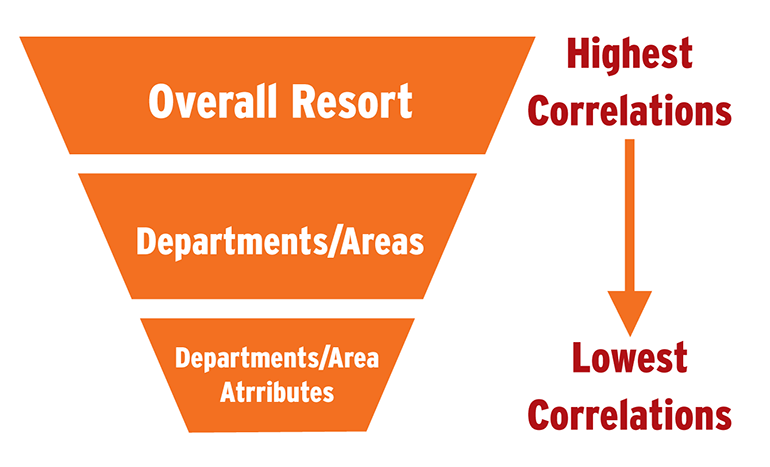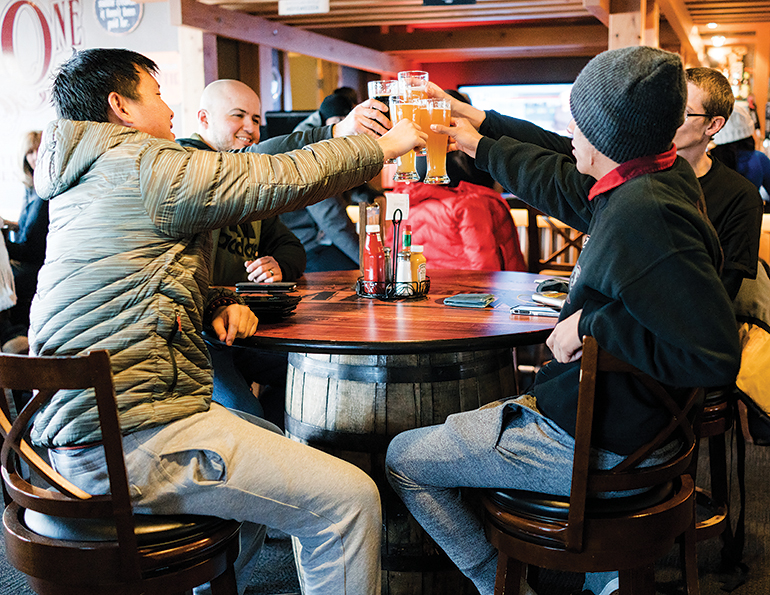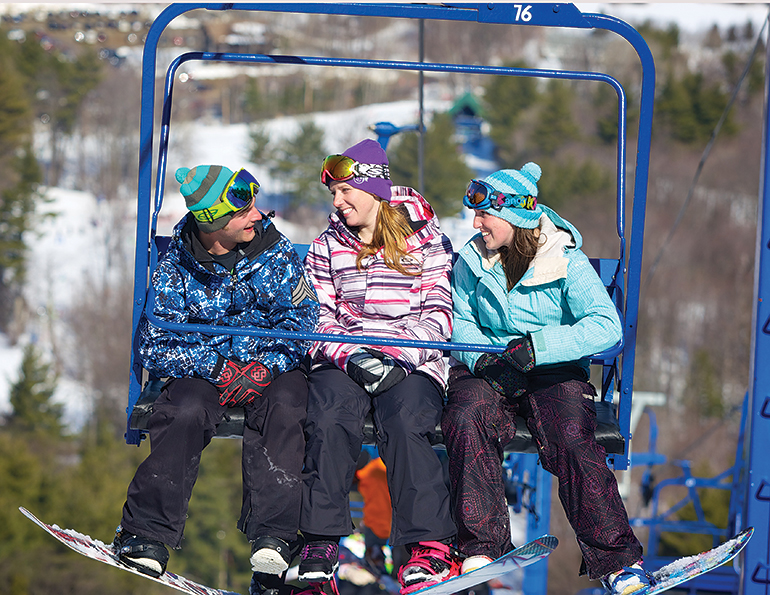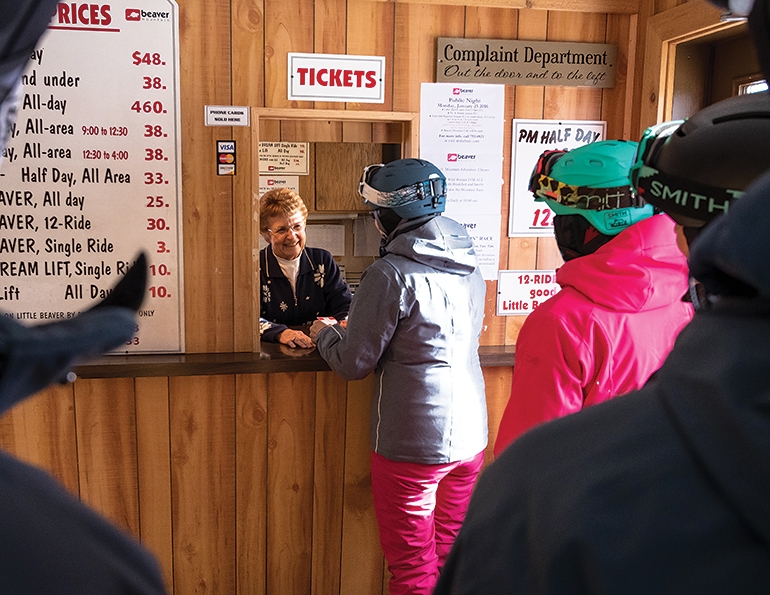A visit to a ski resort consists of many touch points, each of which may impact the guest’s overall visit experience and satisfaction, as well as loyalty, to the resort. Each touch point has the opportunity to impress or to disappoint. These conflicting emotions are very influential in the guest’s likelihood to return and recommend the resort.
Every resort management team must ask, “Where should we focus our resources to enhance the guest experience, increase guest loyalty, and boost revenues and profits through greater repeat and referral business?” However, only a few resorts have a strategic, research-based answer for this question. And ironically, simply asking guests what’s important to them generates unreliable answers.
Instead, here are two proven ways to answer this question, based on guest feedback and highlights from some of our company’s learning.
Two Approaches
The two basic research methods are quantitative (based on the analysis of performance ratings) and qualitative (based on the analysis of verbatim guest comments). Both these methods of isolating the key drivers of satisfaction and loyalty require in-depth guest feedback about the resort’s touch points, from pre-arrival (e.g., website, booking engine and call center) through departure.
Quantitative measurement. Quantitative research measures the impact of different attributes on guests’ overall visit experience/satisfaction and loyalty (their likelihood to recommend the resort). This research is typically conducted using correlation and regression analyses on guest feedback.
Drivers can be identified across overall resort visit attributes (overall family appeal, overall skiing/snowboarding experience), overall department/area attributes (overall rental experience, overall lodging experience), and attributes within a department/area (rental staff friendliness/helpfulness, cleanliness of hotel room). Because overall resort visit attributes are the most inclusive, they have the highest correlations with the overall visit experience/satisfaction and loyalty, followed by overall department/area attributes. But it is important to identify the drivers at each of the three levels.

Analysis of the drivers can inform a wide variety of decisions. Among them:
• Which of the overall visit attributes is most important?
• If you improve overall staff friendliness/helpfulness, how much of an impact will it have on the overall visit experience/satisfaction and likelihood to recommend?
• Which of the overall department/area attributes are most important?
• Is it more important to improve the food & beverage experience or the resort’s accommodations?
• To improve your food & beverage experience, which outlets should you focus on improving? Should you focus on food quality, service quality, or menu variety?
Analyzing Guest Comments. Qualitative research, on the other hand, is based on an analysis of the guests’ responses to open-ended questions, such as, “What changes and additions would you make to increase your likelihood to recommend the resort?”
This analysis requires either manual or machine coding and tabulation to identify the primary themes. Manual coding and tabulation are appropriate when there is a limited number (in the hundreds) of guest comments, but difficult with larger quantities (a thousand or more). Advanced AI-based text and predictive analytics programs can even estimate the impact of the identified themes on the likelihood to recommend.
Learning from Quantitative Drivers
We have conducted quantitative drivers analyses for selective clients for 10 years. Here is some of what we’ve learned:
1. Drivers vary a lot. The quantitative drivers of loyalty and overall visit experience/satisfaction vary by resort. They can also evolve over time; drivers this past season may not be drivers two years from now.
Drivers are affected by the consistency or variability of the performance ratings; the more consistent an attribute’s ratings, the less likely it is to be a key driver. Drivers tend to be things that are either improving or getting worse.
Most of the overall visit and overall department attributes have been key drivers for one or more of the resorts we have studied, but no single attribute has been a driver for all resorts.
2. Satisfaction loyalty. The drivers of loyalty are similar to, yet different from, the drivers of overall visit experience/satisfaction, because loyalty is determined by far more than just the most recent visit experiences.
3. Demographics matter. Key drivers of loyalty and overall visit experience/satisfaction can also vary by age, income, ethnicity, and household composition, among other demographic segments. It is important to know what these differences are in order to make informed decisions.
4. How’s the snow? Snow conditions during the most recent visit impact the guest’s overall visit experience/satisfaction, but are typically not highly correlated with guest loyalty. Similarly, the overall skiing/riding experience is most often a key driver of the overall visit experience/satisfaction, but less of a driver of loyalty.
5. Emotions need to be measured. Emotions, which are rarely measured in guest surveys, are an important driver of loyalty and, to a lesser extent, the overall visit experience/satisfaction. We measure emotions by asking guests to rate certain statements, including “The resort values me as a guest” and “I feel a sense of loyalty to the resort.”
More and more research conducted in various industries has shown that emotions may be even more important to loyalty than are the rational factors of the guest experience. Our drivers analyses confirm this also. (See “Not What, But Why?” p. 77, for more on this topic.)
6. Sizing up the cafeteria. The cafeteria/food court experience drives the overall food & beverage experience. This is where the majority of guests dine and have the least satisfactory experience. (Read about recent F&B improvement projects and get tips on improving cafeterias in “Eat Here,” p. 91.)
 A good day on snow always ends with some après. Guests raise a glass at Brian Head, Utah. Courtesy of Ski Utah. Photo by Austen Diamond Photography.
A good day on snow always ends with some après. Guests raise a glass at Brian Head, Utah. Courtesy of Ski Utah. Photo by Austen Diamond Photography.
7. Instructor or the lesson? Bonding with a lesson instructor is the most important driver for beginners and children who take lessons. Instruction quality/progress, on the other hand, is more important to intermediate and advanced ability lesson takers.
8. Staff have impact. Overall staff friendliness/helpfulness and overall level of fun are often key drivers of both the overall visit experience/satisfaction and loyalty.
9. Happiness is a clean restroom. As the bathroom rating goes up or down, so too will the overall cleanliness rating; the two move together. When overall cleanliness is a driver, it often is caused by low ratings for the public bathrooms.
Learning from Qualitative Drivers
The most important open-end question on our guest surveys is, “What suggestions do you have to increase the likelihood of recommending the resort?” Guests’ verbatim comments can be analyzed through manual or machine coding and tabulation. The latter can also identify the sentiment of each comment, and more advanced systems can measure the impact of a theme on the likelihood to recommend.
In examining the guest comments from 32 resorts with higher volumes of surveys and guest comments, we observed the following:
1. Pricing is key. As with the quantitative drivers analyses, the major themes evident in the guest comments vary by resort and may vary during the season. Pricing was the most prevalent theme, having far more mentions than any other theme.
2. Sticking points: Tickets, food, and lodging. In “unpacking” the pricing theme, the majority of comments pertained to lift ticket/pass prices, followed by food & beverage. For those resorts with lodging, accommodations also received many comments, often referring to the poor value for the price paid.
3. Other key drivers. Other recurring themes included lifts and lift-line management, crowds and long lift lines, lessons, snow conditions, and staff friendliness/helpfulness.
 On the chairlift at Pats Peak, N.H. Courtesy of SkiNH. Photo by Lori Rowell.
On the chairlift at Pats Peak, N.H. Courtesy of SkiNH. Photo by Lori Rowell.
While we identified these themes using manual coding and tabulation, we will soon introduce an AI tool (text and predictive analytics) that machine-analyzes a resort’s guest comments and creates actionable insights to enable managers to increase guest retention and loyalty.
As the battle for skiers and riders intensifies, and as resorts seek better insights from their data, analysis of the quantitative and qualitative drivers will become critical to developing a roadmap for increasing satisfaction and loyalty, thereby generating higher revenues.






